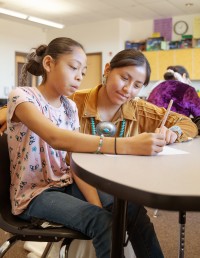Governor Martinez Puts New Mexico at the Forefront of Efforts to Support Students in Foster Care and the Juvenile Justice System
Santa Fe – Governor Susana Martinez has signed two bills that will improve support for students in the state’s care. The legislation was developed in collaboration with young people who have had foster care or juvenile justice experience and their insights were critical to ensuring this legislation would provide meaningful help for system-involved students. The Governor’s action places New Mexico at the forefront of a growing movement to improve educational outcomes for children in foster care, homeless students, and those involved in the juvenile justice system.
The Albuquerque Public Schools applauded the legislation’s sponsors, Senator Gay Kernan and Representatives Doreen Gallegos and Gail Chasey, for getting the bills passed and enacted. “Foster youth are some of our most vulnerable students but we are confident that with the proper supports and systems in place, school districts statewide can change the lives of these students for years to come,” said Carrie Robin Brunder, Director of Government Affairs and Policy for the district. “This legislation is a fundamental game changer for foster youth and we are excited to get to work on its implementation.”
At any given time, there are more than 35,000 children in New Mexico who are homeless, in foster care or involved with the juvenile justice system. Young people in our public systems – especially the child welfare and justice systems –are among the most vulnerable and academically underserved student groups in New Mexico. Their opportunity to learn has been interrupted by frequent home and school moves. They rarely receive credit for the coursework they have completed. They face heartbreakingly limiting expectations for their future.
“System involved students face many barriers that discourage them from completing their education,” says FosterEd: New Mexico Director Grace Spulak. “This law will make sure that these students will be able to get into the classes they need to graduate on time.”
The Federal Government has recently acknowledged the importance of addressing the needs of system involved students in the Every Student Succeeds Act (ESSA). That legislation emphasizes the importance of stability in school placements. According to Senator Kernan “Many of these students who do not have stable home environments, change schools multiple times in a single school year and are more likely to drop out of high school. By easing these transitions, we can improve graduation rates and the future prospects for these students.”
SB 213/HB 301 requires that a student who has transferred due to a disruption in the student’s education has priority placement in courses that meet state graduation requirements. The student must also have equal access to participation in extracurricular activities, sports, career and technical programs, and other special programs. Further schools must assist and advise the student on college and career readiness and must provide the student all special education services to which the student is entitled.
HB 411 will assist in the implementation of ESSA and SB 213/HB 301 by creating a point of contact (POC) for students in foster care or involved with the juvenile justice system, and by requiring the appointment of an “educational decision maker” for all cases involving children alleged to have been abused or neglected. The POC will make sure that system involved students are promptly enrolled when they change schools and that their records and credits are transferred in a timely manner. For students in foster care and for those in juvenile justice, the POC must ensure that the student has the same opportunities, services, and counseling to which they are entitled under state and federal law.
“I’m proud that New Mexico is first in the nation to provide these rights to youth involved in the juvenile justice system,” said Representative Gallegos. “By creating a point of contact in each district, the state will better fulfill its responsibility to these students, including helping them succeed in school, graduate, and become engaged in their education.”
###





